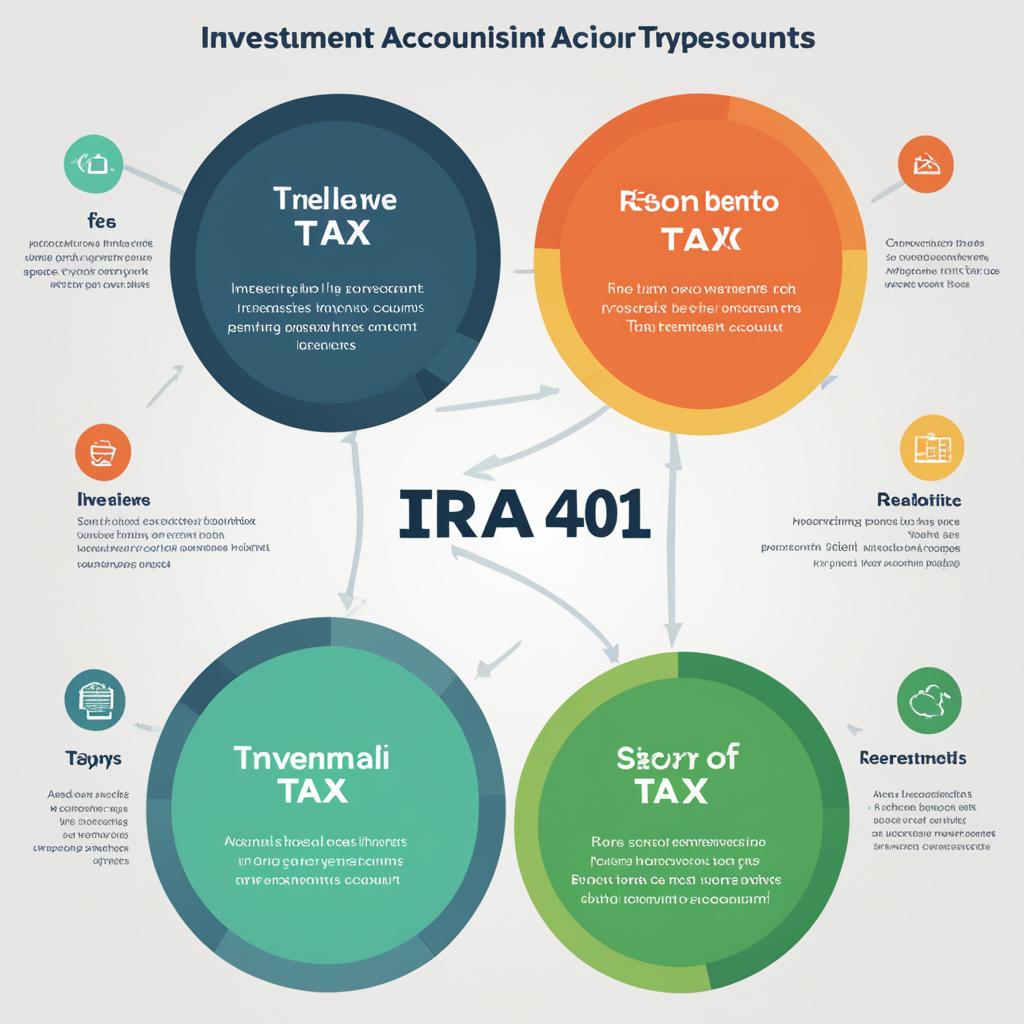When it comes to investing, taxes can have a significant impact on your returns. That’s why tax-efficient investing is crucial. By minimizing taxes, you can maximize your investment returns and keep more of your hard-earned money. In this article, I will share some tips on tax-efficient investing, including the tax benefits of investing and tax optimization strategies.
- Understanding the tax benefits of investing can help you make informed decisions.
- Choosing the right investment accounts, such as taxable accounts and tax-advantaged accounts, is essential for tax efficiency.
- Maximizing the use of tax-advantaged accounts within the annual contribution limits can help maximize tax benefits.
- Investing in tax-efficient investments like tax-managed funds and municipal bonds can minimize tax liabilities.
- Utilizing tax strategies like holding investments longer and tax-loss harvesting can optimize tax efficiency.
Why Is Tax-Efficient Investing Important?
Tax-efficient investing is the key to maximizing your investment returns and minimizing your tax liabilities. By employing tax-efficient strategies, you can keep more of your hard-earned money and achieve your financial goals faster. Whether you’re saving for retirement or generating cash for other purposes, minimizing taxes is essential for optimizing your investment outcomes.
When it comes to investment returns, every dollar counts. Taxes can eat into your profits, significantly impacting your overall returns. By taking steps to minimize taxes, you can increase your after-tax returns and ultimately grow your wealth at a faster pace.
To put it simply, tax-efficient investing means being strategic in the management of your investments in order to minimize the taxes you have to pay. This involves making smart investment choices, utilizing the right investment accounts, and implementing tax-saving strategies.
Now, let’s take a closer look at why tax-efficient investing is so critical for your financial success.
- Maximizing Returns: By minimizing taxes, you can maximize your after-tax returns. This means more money in your pocket and a higher potential for growth.
- Preserving Capital: Minimizing taxes helps to preserve your capital and protect your investment gains, allowing you to compound your wealth over time.
- Enhancing Cash Flow: Minimizing taxes can also improve your cash flow, putting more money in your hands for current expenses or future investments.
By investing in a tax-efficient manner, you can optimize your financial outcomes and pave the way for long-term success. The next sections will delve deeper into various strategies and considerations for tax-efficient investing, including different types of investment accounts, tax-efficient investments, and more.
Types of Investment Accounts
When it comes to tax-efficient investing, choosing the right investment accounts can make a significant difference in maximizing your returns and minimizing your taxes. There are two main types of investment accounts to consider: taxable accounts and tax-advantaged accounts.
Taxable accounts, such as brokerage accounts, offer flexibility in terms of investment options. However, they do not come with any specific tax benefits. This means that any gains made on investments held in taxable accounts are subject to taxes in the year they are realized.
On the other hand, tax-advantaged accounts like Individual Retirement Accounts (IRAs) and 401(k)s offer various tax advantages. These accounts provide opportunities for tax-deferred growth or even tax-free withdrawals in retirement, depending on the account type.
Understanding the advantages and disadvantages of each account type is essential in creating a tax-efficient investment strategy. Let’s take a closer look at the different types of investment accounts:
1. Taxable Accounts
Definition: Taxable accounts, also known as brokerage accounts, are investment accounts that are not associated with any specific tax benefits.
In taxable accounts, you have the freedom to invest in a wide range of options, including stocks, bonds, mutual funds, and more. However, any gains made on investments held in taxable accounts are subject to taxes in the year they are realized. This means you may need to pay capital gains taxes, dividend taxes, and taxes on interest income.
While taxable accounts don’t offer any tax advantages, they do provide flexibility. You can access your funds at any time without any penalties or restrictions, which makes them ideal for short-term financial goals or emergency funds.
2. Tax-Advantaged Accounts
Definition: Tax-advantaged accounts, such as IRAs and 401(k)s, offer specific tax benefits, allowing you to minimize your tax burden and maximize your investment returns.
There are different types of tax-advantaged accounts, each with its own set of rules and benefits. Here are two popular options:
| Account Type | Tax Benefits | Contribution Limits (2024) |
|---|---|---|
| Traditional IRA | Contributions may be tax-deductible, and earnings grow tax-deferred until withdrawn. | $6,000 ($7,000 if 50 or older) |
| 401(k) | Contributions are made with pre-tax dollars, reducing your current taxable income. | $19,500 ($26,000 if 50 or older) |
By taking advantage of tax-advantaged accounts, you can potentially lower your tax liability and increase the growth of your investments. For example, contributing to a traditional IRA can provide a tax deduction, effectively reducing your taxable income for the year. This can result in significant tax savings. Similarly, contributing to a 401(k) allows you to lower your current taxable income, potentially putting you in a lower tax bracket.
Understanding the nuances of each tax-advantaged account type and their contribution limits is crucial in developing a tax-efficient investment strategy.
Choosing the right investment accounts is an important step in tax-efficient investing. By considering factors such as flexibility, tax advantages, and contribution limits, you can optimize your investment strategy and work towards maximizing your returns while minimizing your tax burden.
Tax-Efficient Investing Strategies
When it comes to tax-efficient investing, maximizing the benefits of tax-advantaged accounts is key. These accounts, such as IRAs and 401(k)s, offer tax advantages that can significantly contribute to your overall tax efficiency. However, it’s important to be mindful of the annual contribution limits.
One strategy for maximizing tax efficiency is to prioritize tax-efficient investments within these accounts. Investments that are tax-efficient, such as index funds or ETFs, can be held in tax-advantaged accounts to take advantage of their tax benefits.
However, it’s worth noting that tax-advantaged accounts have contribution limits, which means that not all investments can fit within these accounts. This is where taxable accounts come into play. Taxable accounts can hold investments that may not be as tax-efficient, such as actively managed funds or individual stocks.
To illustrate this strategy, let’s take a look at an example:
| Investment | Account Type |
|---|---|
| Index Fund | IRA |
| Actively Managed Fund | Taxable Account |
| Individual Stocks | Taxable Account |
| Real Estate Investment Trusts (REITs) | IRA |
By strategically allocating tax-efficient investments to tax-advantaged accounts and less tax-efficient investments to taxable accounts, you can increase your overall tax efficiency.
Additionally, when considering tax-efficient investing strategies, it’s important to be mindful of the tax implications of different investments. For example, investments that generate regular income, such as bonds or dividend-paying stocks, may be more suitable for tax-advantaged accounts.
Remember, the ultimate goal of tax-efficient investing is to maximize returns by minimizing taxes. To achieve this, it’s essential to understand the tax benefits of different account types, consider annual contribution limits, and optimize your investment allocation across various accounts.
Tax-Efficient Investing Checklist:
- Maximize tax-advantaged accounts within annual contribution limits.
- Hold tax-efficient investments in tax-advantaged accounts.
- Utilize taxable accounts for less tax-efficient investments.
- Consider the tax implications of different investments.
- Consult with a financial advisor or tax professional to maximize tax efficiency.
“Harnessing the power of tax-advantaged accounts and strategic investment allocation can significantly enhance your tax efficiency and help you keep more of your hard-earned money.”
Tax-Efficient Investments
When it comes to tax-efficient investing, not all investments are created equal. Some investments are more tax-efficient than others, meaning they can help minimize your tax liability and maximize your after-tax returns. Here are three types of tax-efficient investments to consider:
Tax-Managed Funds and ETFs
One option for tax-efficient investing is to choose tax-managed funds and exchange-traded funds (ETFs) within the stock fund category. These funds tend to trigger fewer capital gains, resulting in potentially lower tax liabilities. By actively managing their portfolios to minimize taxable events, tax-managed funds and ETFs help investors keep more of their investment returns.
Municipal Bonds
Municipal bonds are another tax-efficient investment option. The interest income earned from municipal bonds is often tax-exempt at the federal, state, and local levels. This means that the income you receive from these bonds is not subject to federal income tax, and depending on where you live, it may also be exempt from state and local taxes. Municipal bonds can be an attractive choice for investors looking to generate tax-free income.
Real Estate Investment Trusts (REITs)
REITs are an investment option that can provide tax advantages. As a shareholder of a REIT, you can benefit from the pass-through taxation structure, which means that the income generated by the REIT is generally not taxed at the corporate level. Instead, the income is passed through to the shareholders, who are responsible for paying taxes on their share of the income. REITs can be a tax-efficient way to invest in real estate without the hassle of direct property ownership.
By understanding which investments are more tax-efficient, you can make informed decisions about your portfolio allocation. Consider incorporating tax-managed funds, municipal bonds, and REITs into your investment strategy to help minimize your tax liability and maximize your after-tax returns.

| Investment Type | Tax Efficiency |
|---|---|
| Tax-Managed Funds and ETFs | Trigger fewer capital gains, potentially lowering tax liabilities. |
| Municipal Bonds | Interest income is often tax-exempt at the federal, state, and local levels. |
| Real Estate Investment Trusts (REITs) | Pass-through taxation structure may result in lower taxes for shareholders. |
What Does Tax Efficient Investing Mean?
Tax-efficient investing is a crucial strategy for investors who want to maximize their returns and minimize taxes. This approach involves carefully selecting investments and implementing strategies that minimize the tax burden on investment returns. By being mindful of taxes and utilizing tax-efficient investment strategies, investors can optimize their return on investment and keep more of their hard-earned money.
When it comes to tax-efficient investing, the goal is to make strategic decisions that will help you legally minimize your tax liabilities while maximizing your after-tax returns. This means strategically managing your investment portfolio to take advantage of tax benefits and reduce unnecessary taxes.
“Tax-efficient investing is all about keeping more of what you earn. By employing tax optimization strategies, you can put more money back into your pocket and increase your overall investment returns.”
To achieve tax efficiency in your investments, it’s important to consider factors such as the types of investment accounts you utilize, the specific tax advantages they offer, and the tax implications of different investment choices. By making informed decisions and taking advantage of available tax benefits, you can significantly impact your overall investment returns.
Consulting with a financial or investment professional who specializes in tax-efficient investing can provide valuable guidance and help ensure that your investment strategies align with your individual financial goals. These professionals can help you understand the various tax-efficient investment options available and develop a tailored investment plan that minimizes your tax liabilities while maximizing your investment returns.
What are the key principles of tax-efficient investing?
- Strategic asset location: By strategically locating your investments in tax-efficient accounts, such as IRAs and 401(k)s, you can minimize the impact of taxes on your investment returns.
- Tax-efficient investments: Certain investments, like municipal bonds and tax-managed funds, are known for their tax efficiency. These investments generate income that is either tax-exempt or subject to lower tax rates, helping to minimize your overall tax liability.
- Minimizing portfolio turnover: High portfolio turnover can lead to increased taxes due to capital gains. Minimizing unnecessary buying and selling of investments can help reduce capital gains taxes and improve tax efficiency.
- Tax-loss harvesting: This strategy involves selling investments that have experienced losses to offset capital gains and reduce tax liability. By harvesting losses strategically, you can minimize your tax burden and potentially improve your overall investment returns.
Implementing these tax-efficient investing strategies can make a significant difference in your investment outcomes. However, it’s important to remember that everyone’s tax situation is unique. Be sure to consult with a tax professional or financial advisor before implementing any tax-efficient investing strategies to ensure they align with your specific circumstances.
What Are the Tax Benefits of a 401(k)?
One of the main tax benefits of a 401(k) plan is the ability to make pre-tax contributions. Contributions to a 401(k) are made with pre-tax dollars, which reduces the individual’s taxable income for the year. This can result in a lower tax bill.
By contributing to a 401(k) on a pre-tax basis, individuals can effectively lower their taxable income, which means they will owe less in taxes. For example, if an individual earns $50,000 a year and contributes $5,000 to their 401(k), their taxable income will be reduced to $45,000. As a result, their tax liability will be based on the lower income amount.
Additionally, the earnings on a 401(k) grow on a tax-deferred basis, meaning individuals do not have to pay taxes on the investment gains until they withdraw the funds in retirement. This allows the investments in the 401(k) to potentially grow at a faster rate, as taxes on the gains are deferred.
It’s important to note that while there are tax benefits associated with 401(k) contributions, there are also certain limitations. Each year, the IRS sets contribution limits that individuals must adhere to. For example, in 2024, the limit for 401(k) contributions is $19,500, with an additional catch-up contribution of $6,500 for individuals aged 50 and over.
“Contributing to a 401(k) on a pre-tax basis can lower your tax bill and help you save more for retirement.” – Jane Smith, Certified Financial Planner
Comparison of Tax Benefits: 401(k) vs. Traditional IRA
| 401(k) | Traditional IRA |
|---|---|
| Contributions are made with pre-tax dollars | Contributions may be tax-deductible, depending on income and eligibility |
| Earnings grow on a tax-deferred basis | Earnings also grow on a tax-deferred basis |
| Taxed upon withdrawal in retirement | Taxed upon withdrawal in retirement |
| Contribution limits in 2024: $19,500 with a $6,500 catch-up contribution | Contribution limits in 2024: $6,000 with a $1,000 catch-up contribution |
Consultation with a professional tax advisor can provide personalized guidance on the specific tax benefits and limits of a 401(k) plan. They can help individuals understand how to make the most of the pre-tax contribution opportunities, while also ensuring compliance with IRS regulations and avoiding potential penalties or fees.

Investing in Your Future
Maximizing the tax benefits of a 401(k) can play a crucial role in building a solid financial foundation for the future. By taking advantage of these benefits, individuals can lower their tax liabilities, potentially increase their retirement savings, and work towards achieving their long-term financial goals.
However, it’s important to remember that every individual’s financial situation is unique, and what works for one person may not work for another. It’s recommended to work with a qualified financial advisor who can provide personalized advice and help develop a comprehensive retirement strategy that aligns with individual goals and circumstances.
How Much Can I Contribute to my 401(k) in 2024?
401(k) contribution limits determine the maximum amount you can contribute to your retirement account each year. It’s important to be aware of these limits as they can affect your retirement savings strategy and tax advantages. In 2024, the contribution limit for a 401(k) is $22,500. This means you can contribute up to $22,500 of your pre-tax income to your 401(k) account throughout the year.
If you’re aged 50 or over, you may also be eligible for catch-up contributions. In 2024, the catch-up contribution limit is $7,500. This allows individuals aged 50 and over to contribute an additional $7,500 on top of the regular contribution limit. Catch-up contributions provide an opportunity to boost your retirement savings if you’re behind on your savings goals.
It’s important to note that these contribution limits may change each year, so it’s essential to stay up to date with the latest limits. In 2024, the contribution limit for a 401(k) increases to $23,000, with the same catch-up contribution limit of $7,500 for individuals aged 50 and over.
To better understand the contribution limits and how they may impact your retirement savings, consider consulting with a financial advisor or tax professional who can provide personalized guidance based on your specific financial situation and goals.
Contribute to Tax-Efficient Accounts
When it comes to planning for retirement, having tax-efficient accounts can make a significant difference in reducing your current and future tax liabilities. By utilizing the right retirement accounts, such as traditional IRAs, Roth IRAs, and 401(k) plans, you can optimize your tax savings and maximize the growth of your retirement savings.
Traditional IRA
A traditional IRA allows you to contribute pre-tax income, reducing your taxable income for the year. This means that you won’t pay taxes on the money you contribute to your traditional IRA until you withdraw it during retirement. It’s a tax-deferred account that provides potential tax savings now, allowing your contributions to grow tax-free until retirement.
Roth IRA
A Roth IRA, on the other hand, requires you to contribute after-tax income. While you won’t get an immediate tax deduction, the earnings and withdrawals from a Roth IRA are tax-free, as long as you meet certain requirements. This makes a Roth IRA an attractive option if you anticipate being in a higher tax bracket during retirement or if you want tax-free income in retirement.
401(k) Plan
A 401(k) plan is a retirement savings plan sponsored by your employer. Contributions to a 401(k) plan are made with pre-tax income, reducing your taxable income for the year. This can translate into immediate tax savings by lowering your tax bill. Additionally, any investment earnings within the 401(k) plan grow tax-deferred until you make withdrawals during retirement.
Understanding the tax benefits and contribution limits of these tax-efficient retirement accounts is essential in developing a strategic retirement savings plan. It’s recommended to consult with a financial advisor or tax professional to determine the best approach for your individual circumstances.
By taking advantage of tax-efficient retirement accounts like traditional IRAs, Roth IRAs, and 401(k) plans, you can minimize your tax burden now and in the future. These accounts offer unique tax benefits that can help you maximize your retirement savings and ensure a more financially secure future.
Diversify your account types
Diversifying your investment account types is an essential strategy for optimizing your tax situation in retirement and maximizing your after-tax returns. By mixing and matching income sources from different account types, you can take advantage of their varying tax treatments and reduce your overall tax liability.
There are different types of investment accounts, each with its own tax advantages and considerations:
| Account Type | Tax Treatment |
|---|---|
| Traditional IRAs | Tax-deferred growth potential |
| Pre-tax 401(k) contributions | Tax-deferred growth potential |
| Roth IRAs | Tax-free growth potential |
| Roth 401(k) contributions | Tax-free growth potential |
Diversifying the types of accounts you hold can provide flexibility and enable you to strategically withdraw funds during retirement. Traditional IRAs and pre-tax 401(k) contributions allow for tax-deferred growth, meaning you won’t owe taxes on investment gains until you withdraw the funds. On the other hand, Roth IRAs and Roth 401(k) contributions offer tax-free growth potential, allowing you to withdraw your earnings tax-free in retirement.
By striking a balance and holding a combination of these account types, you can create an investment strategy that optimizes your tax situation and supports your long-term financial goals.
Choose Tax-Efficient Investments
When it comes to investing, choosing tax-efficient investments can make a significant difference in minimizing tax liabilities and maximizing your after-tax returns. By understanding the tax benefits and potential tax consequences of different investments, you can make informed decisions that align with your tax optimization strategy.
One example of a tax-efficient investment is municipal bonds. These bonds often provide tax-exempt interest income at the federal, state, and local levels. By investing in municipal bonds, you can potentially reduce or eliminate the taxes you owe on the interest earned, allowing you to keep more of your investment returns.
Tax-managed mutual funds are another option to consider. These funds are specifically designed to actively work towards tax efficiency. The fund managers employ strategies to minimize the capital gains distributions that can trigger taxes for investors. By selecting tax-managed mutual funds, you can potentially reduce your tax burden and optimize your after-tax returns.
Index funds and exchange-traded funds (ETFs) can also be tax-efficient investment choices. These funds are passively managed and generally have low turnover, which means they generate fewer taxable events, such as capital gains distributions. By investing in index funds or ETFs, you can benefit from their passive nature and potentially reduce your tax liabilities.
When choosing tax-efficient investments, it’s important to consider your overall investment strategy and objectives. Consulting with a financial advisor or investment professional can provide valuable insights and help you make informed decisions that align with your financial goals.
The Benefits of Tax-Efficient Investments:
- Minimize tax liabilities
- Maximize after-tax returns
- Potential tax-exempt interest income
- Reduce capital gains distributions
- Optimize tax optimization strategy
“Choosing tax-efficient investments can help you minimize tax liabilities and maximize your after-tax returns.”
In summary, selecting tax-efficient investments, such as municipal bonds, tax-managed mutual funds, and index funds/ETFs, can play a crucial role in minimizing your tax burden and optimizing your investment returns. By understanding the tax benefits and potential tax consequences of different investment options, you can make smart investment choices that align with your tax optimization strategy.
Match investments with the right account type
When it comes to tax-efficient investing, matching investments with the right account type is crucial for maximizing tax benefits. By aligning your investments with the appropriate account type, you can optimize your tax situation and maximize tax efficiency.
First, consider the investment account types available to you. There are various options, including taxable accounts and tax-advantaged accounts like traditional IRAs and Roth IRAs. Taxable accounts offer flexibility but do not provide any tax benefits, while tax-advantaged accounts offer specific tax advantages.
If you have taxable investments that generate regular taxable income, it may be more beneficial to hold them in tax-deferred accounts, such as traditional IRAs. By doing so, you can defer paying taxes on the income generated by these investments, helping to reduce your current tax liability.
On the other hand, if you have tax-neutral investments, such as tax-managed mutual funds, you may find it more suitable to hold them in taxable brokerage accounts. Since these investments generate income that is already tax-efficient or has minimal tax implications, there is no need to take advantage of the tax benefits offered by tax-advantaged accounts. By keeping tax-neutral investments in taxable accounts, you can maintain flexibility and avoid unnecessary restrictions.
Here’s an example to illustrate how matching investments with the right account type can maximize tax benefits:
| Investment | Account Type | Tax Benefit |
|---|---|---|
| High-yield dividend stocks | Tax-deferred account (traditional IRA) | Deferred taxes on dividends until withdrawal |
| Tax-managed mutual funds | Taxable brokerage account | No need to utilize tax benefits of a tax-advantaged account |
By understanding which account type is most suitable for each investment, you can ensure that you are taking full advantage of the available tax savings and maximizing your tax efficiency.
Remember, it’s always a good idea to consult with a financial advisor or tax professional to fully understand the tax implications and to develop a personalized investment strategy that aligns with your financial goals.

Matching investments with the right account type maximizes tax benefits and helps optimize your tax situation.
Hold investments longer to avoid unnecessary capital gains
When it comes to investing, holding your investments for a longer period can have significant tax benefits. By understanding the concept of capital gains and the associated tax implications, you can make informed decisions to minimize your tax liabilities and maximize your after-tax returns.
Capital gains tax is a tax on the profit you make from selling an investment that has appreciated in value. The holding period of an investment determines whether the gains are classified as short-term or long-term capital gains.
Short-term capital gains apply to investments held for one year or less. These gains are taxed at your ordinary income tax rate, which can be significantly higher compared to long-term capital gains rates.
Long-term capital gains apply to investments held for more than one year. The tax rates for long-term capital gains are typically lower than ordinary income tax rates, offering potential tax savings. The specific tax rates for long-term capital gains depend on your income level.
To illustrate the benefits of holding investments longer, consider the following example:
| Investment | Holding Period | Gain/Loss | Tax Rate | Tax | After-Tax Return |
|---|---|---|---|---|---|
| Stock A | 1 year | $10,000 | Short-term | $2,800 | $7,200 |
| Stock B | 2 years | $10,000 | Long-term | $1,500 | $8,500 |
In the example above, both stocks realized a gain of $10,000. However, by holding Stock B for two years and qualifying for long-term capital gains treatment, the investor was able to reduce their tax liability by $1,300 compared to Stock A, resulting in a higher after-tax return of $8,500.
Delaying the sale of appreciated investments until they qualify for long-term capital gains treatment can be a tax-efficient strategy, especially for high-income individuals who may be subject to higher tax rates.
By holding investments for a longer period, you can potentially save on taxes and increase your after-tax returns. Understanding the tax implications of your investment decisions and consulting with a tax advisor can help you make informed choices and optimize your tax efficiency.
Remember that tax laws and rates can change, so it’s essential to stay updated on any updates or adjustments that may impact your investment strategy.
Consult with a tax advisor for personalized advice
As tax rules can be complex and unique to individual circumstances, it’s important to consult with a qualified tax advisor who can provide personalized advice tailored to your specific financial situation. They can help you navigate the intricacies of tax laws, optimize your tax efficiency, and ensure that you comply with all relevant regulations.
Overall, holding investments longer to qualify for long-term capital gains treatment is a tax-efficient strategy that can potentially increase your after-tax returns. Speak to a tax advisor to understand how this strategy aligns with your investment goals and explore other tax planning opportunities to maximize your overall financial success.
Harvest losses to offset gains
Tax-loss harvesting is a valuable strategy for investors looking to reduce their tax liability and optimize their investment returns. This method involves utilizing investment losses to offset gains, ultimately lowering the taxable income for the year. By doing so, investors can potentially save on taxes and keep more of their hard-earned money.
When implementing tax-loss harvesting, it’s important to understand how it works. Investment losses can be used to offset up to $3,000 of federal taxable income each year. Additionally, any remaining losses can be carried forward to future tax years, providing further tax benefits. This allows investors to strategically manage their investment losses and minimize their overall tax burden.
One significant advantage of tax-loss harvesting is its usefulness for higher-income investors who may be subject to higher long-term capital gains tax rates. By offsetting gains with losses, these investors can potentially reduce their tax liability significantly, resulting in substantial savings in the long run.
However, it’s crucial to be aware of the wash sale rules when implementing tax-loss harvesting. The wash sale rule prevents investors from selling a security at a loss and then immediately repurchasing the same or a substantially identical security. Violating this rule can disallow the tax benefits of the loss. Consulting with a tax advisor can help ensure compliance with the wash sale rules and optimize the tax efficiency of the tax-loss harvesting strategy.
Remember, tax-loss harvesting is just one aspect of a comprehensive tax-efficient investment strategy. It’s always a good idea to work with a financial advisor or tax professional who can provide personalized guidance based on your individual financial situation and goals.

Key Takeaways:
- Tax-loss harvesting involves using investment losses to offset gains and reduce tax liability.
- Investment losses can be used to offset up to $3,000 of federal taxable income each year.
- Remaining losses can be carried forward to future tax years for additional tax benefits.
- This strategy is particularly beneficial for higher-income investors subject to higher long-term capital gains tax rates.
- It’s crucial to understand and comply with wash sale rules to ensure the effectiveness of tax-loss harvesting.
Conclusion
Tax-efficient investing is a crucial strategy for maximizing returns and minimizing taxes. By carefully selecting tax-efficient investments and utilizing the right investment accounts, investors have the opportunity to optimize their after-tax returns and preserve more of their hard-earned money.
Implementing a tax-efficient investment strategy requires thoughtful consideration and guidance from financial and tax professionals. Working with a financial advisor can help develop a personalized investment plan that aligns with individual goals and risk tolerance, while a tax advisor can provide insights on tax rules and regulations.
By leveraging tax-efficient investment strategies, individuals can navigate the complexities of the tax code and strive for long-term financial success. Whether it’s utilizing tax-advantaged accounts, diversifying account types, or matching investments with the right tax treatment, every decision made with the goal of minimizing taxes can have a significant impact on investment returns and overall wealth accumulation.
FAQ
What is tax-efficient investing?
Tax-efficient investing refers to strategies and techniques used to minimize the tax burden on investment returns. It involves selecting tax-efficient investments, utilizing the right investment accounts, and implementing tax-efficient strategies.
Why is tax-efficient investing important?
Tax-efficient investing is important because taxes can significantly impact investment returns. By minimizing taxes, investors can maximize their after-tax returns and keep more of their money.
What are the types of investment accounts?
There are two main types of investment accounts: taxable accounts and tax-advantaged accounts. Taxable accounts, such as brokerage accounts, offer flexibility but do not have any tax benefits. Tax-advantaged accounts like IRAs and 401(k)s provide tax advantages, such as tax-deferred growth or tax-free withdrawals in retirement.
What are some tax-efficient investing strategies?
Tax-efficient investing strategies involve maximizing the use of tax-advantaged accounts within the annual contribution limits. It also involves putting tax-efficient investments in taxable accounts and less tax-efficient investments in tax-advantaged accounts. Additionally, holding investments for a longer period and utilizing tax-loss harvesting can help minimize taxes.
What are some tax-efficient investments?
Tax-efficient investments include tax-managed funds, exchange-traded funds (ETFs), municipal bonds, and real estate investment trusts (REITs). Understanding which investments are more tax-efficient can help investors make informed decisions about their portfolio allocation.
What does tax efficient investing mean?
Tax-efficient investing means maximizing returns by minimizing taxes. It involves selecting tax-efficient investments, utilizing the right investment accounts, and implementing tax-efficient strategies to optimize return on investment and keep more of the money earned.
What are the tax benefits of a 401(k) account?
The main tax benefit of a 401(k) account is the ability to make pre-tax contributions. This reduces taxable income for the year, resulting in a lower tax bill. However, it is essential to stay within the contribution limits to avoid penalties and fees.
How much can I contribute to my 401(k) in 2024?
In 2024, the contribution limit for a 401(k) is ,500, with an additional catch-up contribution of ,500 for individuals aged 50 and over. It is crucial to be aware of these limits to maximize the benefits of a 401(k) plan.
What are some tax-efficient retirement accounts?
Tax-efficient retirement accounts include traditional IRAs, Roth IRAs, and 401(k) plans. Contributions to traditional IRAs may be tax-deductible, while contributions to Roth IRAs are made on an after-tax basis. Contributions to a 401(k) plan can be made pre-tax, reducing current taxable income.
How can diversifying investment account types help with tax efficiency?
Diversifying investment account types allows for mixing and matching income sources in retirement to minimize taxes. Different account types have different tax treatments, such as tax-deferred growth potential in traditional IRAs and tax-free growth potential in Roth IRAs.
How do I choose tax-efficient investments?
Choosing tax-efficient investments involves considering factors such as tax-exempt interest income, capital gains consequences, and the passive nature of investments. Investments like municipal bonds, tax-managed mutual funds, and certain exchange-traded funds (ETFs) can be tax-efficient choices.
How do I match investments with the right account type?
Matching investments with the right account type involves considering the tax benefits of each account. Taxable investments generating regular taxable income may be better suited for tax-deferred accounts like traditional IRAs, while tax-neutral investments may be more suitable for taxable brokerage accounts.
How can holding investments longer help minimize taxes?
Holding investments for a longer period can help individuals avoid unnecessary capital gains taxes. Gains from stocks held for more than a year qualify as long-term capital gains, which are taxed at a lower rate compared to short-term capital gains.
What is tax-loss harvesting?
Tax-loss harvesting involves using investment losses to offset investment gains and reduce tax liability. The losses can be used to offset up to ,000 of federal taxable income each year and can be carried forward to future tax years.
How can tax-efficient investing help maximize returns?
Tax-efficient investing can help maximize returns by minimizing taxes. By selecting tax-efficient investments, utilizing the right investment accounts, and implementing tax-efficient strategies, investors can optimize their after-tax returns and keep more of their money.
Our Friends
- https://www.investopedia.com/articles/stocks/11/intro-tax-efficient-investing.asp
- https://www.schwab.com/learn/story/tax-efficient-investing-why-is-it-important
- https://www.merrilledge.com/article/tax-smart-investment-strategies-you-should-consider
Money posts:
 7 Best Investments for Taxable Accounts (2024)
7 Best Investments for Taxable Accounts (2024)
 What are the 401(k) Contribution Limits for? (2024)
What are the 401(k) Contribution Limits for? (2024)
 Types of Investment Accounts
Types of Investment Accounts
 Solo 401k Contribution Limits for 2024 and Beyond
Solo 401k Contribution Limits for 2024 and Beyond
 How to Invest $1 Million Dollars: Strategies and Tips for Growth and Security
How to Invest $1 Million Dollars: Strategies and Tips for Growth and Security
 Retirement Financial Advisor: Types + Responsibilities (2024)
Retirement Financial Advisor: Types + Responsibilities (2024)
 SEP IRA Contribution Limits for 2024 and 2024
SEP IRA Contribution Limits for 2024 and 2024
 Solo 401k Rules for Your Self-Employed Retirement Plan (2024)
Solo 401k Rules for Your Self-Employed Retirement Plan (2024)

